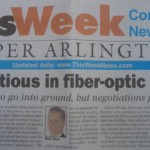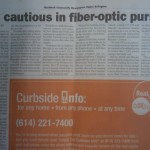ThisWeek 4/13/2011
The conduit is going into the ground, but city officials have said negotiations with Columbus-based fiber-optic network provider Bluemile have yet to make a connection.
“Negotiations have slowed,” city attorney Jeanine Hummer said. “We’ve had a very favorable relationship with Bluemile in this process, but until we can get to a place where everything makes sense, we can’t put a contract in place.”
The idea for the project initially derived from the Upper Arlington City Schools.
“[The city] has some bandwidth issues but the school has really been the driver,” said Matt Shad, deputy city manager for economic development. “But we saw an opportunity for partnership to solve some of our issues, help the schools and create a new economic development tool to potentially bring high-value data knowledge worker jobs to our small offices.”
School officials, Shad said, realized that they were spending a lot of money on leased data lines to send data between their own buildings. Fiber-optic networks are almost limitless in their data carrying capacity because of how they work, using light to transmit data.
“Our current contract with AT&T costs us $8,600 a month,” Upper Arlington City Schools treasurer Andy Geistfeld said. “Because the contract ends in June, the school had to act now to maintain data services as well as to meet timelines for federal reimbursements. We have just signed a new agreement for another two years of service with AT&T.”
The school’s bandwidth demands continue to grow, and Geistfeld said the monthly costs will increase by $2,000 to $3,000 a month over the next year to meet that demand.
“We have to look at ways to decrease future costs while meeting our ever-growing data demands,” Geistfeld said. “The new [AT&T] contract gives us some breathing room but we are continuing the conversation [with Bluemile].”
Work along Lane Avenue, between Kenny Road and Riverside Drive, to install a power transmission line provided the city with the opportunity to lay the fiber conduit, which may someday carry the high-speed fiber-optic network. In an agreement with AEP, city engineer Tom Komlanc said the power company will install the conduit purchased by the city at no cost for labor.
“The cost of the fiber network isn’t in the material,” Shad said. “Pulling 96 strands of fiber-optic cable doesn’t really cost anymore than pulling 8, and if the city and schools only use 8 that leaves a lot of capacity for other uses.”
Shad has been working with other city officials to negotiate an agreement for installation and management of the open access fiber-optic network with Bluemile.
An open access fiber-optic network means that the city would be able to allow any number of service providers to market data services over the network, as opposed to current data networks in the city that are proprietary to a single provider.
The fiber-optic cabling necessary to create the high-speed network won’t be installed as a part of the AEP project. Instead, Request for Information (RFI) responses, due June 4, 2010, asked for vendors to provide the city with their best ideas for cable installation and how to implement and manage a city-owned open access fiber-optic network in the city.
Twelve vendors were notified of the RFI, four responded: AT&T, Bluemile, Horizon Telecom Inc. of Chillicothe, and Datacenter.bz of Worthington.
Bluemile also holds fiber-optic network contracts with Gahanna, New Albany and Dublin, and continues to expand the Columbus Fiber Network project that includes several other outer-ring suburbs.
“[Gahanna] has an indefeasible right to use with the Community Improvement Corporation, which gives the Bluemile-managed bandwidth to the Community Improvement Corporation to market services to the business community. The CIC leverages that use as a revenue stream back to the city,” Gahanna technology director Tom Kneeland said. “We feel that building out this infrastructure has become the fourth utility and it is expected by the business community.”
Gahanna’s fiber-optic network also serves as the backbone for its citywide Wi-Fi system. The Wi-Fi network serves both businesses and residents.
Upper Arlington and surrounding northwest Columbus neighborhoods inside I-270 are like an island, Shad said, because there are currently no open-access fiber-optic networks running through the area. The Columbus Fiber Network currently connects suburbs outside of I-270 with Bluemile’s downtown Columbus data center as a way of driving competition in the central Ohio broadband market, according to Bluemile’s website.
“We built CFN as an open access conduit system to help foster competitive broadband access for central Ohio,” CFN general manager Ian Smith said.
The city, schools and other potential partners in the project are currently weighing the possibility of this project being enough of a low-risk return on investment to move forward with it, according to Shad. Currently, there is no time-line in place for completing negotiations with any of the RFI respondents.
“The ability to move operations costs to capital costs can be appealing, as well as filling in services to areas that don’t currently have service – and the ability to offer competitive options for those services,” Shad said. “But code makes public-private partnerships complicated to pull together. What it comes down to for [the city] is that if this isn’t a joint project [between the city, school and vendor] then this isn’t a project.”

